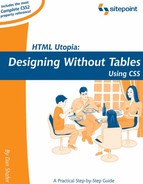Book Description
This book is for Web Developers who want to develop or migrate existing websites from using table-based layouts to using Cascading Style Sheets, which allows for faster page downloads, easier maintainence, faster Website re-designs and better search engine optimization.
HTML Utopia covers all aspects of using Cascading Style Sheets in Web Development, and is a must-read for Web Developers designing new sites or upgrading existing ones to use CSS layouts.
This book includes one of the most comprehensive CSS2 references on the market. Jeffrey Zeldman, web design guru and co-founder of the Web Standards Project says about this book "After reading this book, you will not only understand how to use CSS to emulate old-school, table driven web layouts, you will be creating Web sites that would be impossible to design using traditional methods".
Table of Contents
- Dedication
- About the Author
- Preface
- Introduction to CSS
- Page Layout with CSS
- Styling Text and other Content with CSS
- Non-Obvious Uses of CSS
- CSS Miscellany
- CSS Property Reference
- azimuth
- background
- background-attachment
- background-color
- background-image
- background-position
- background-position-x, background-position-y
- background-repeat
- behavior
- border
- border-bottom, border-left, border-right, border-top
- border-bottom-color, border-left-color, border-right-color, border-top-color
- border-bottom-style, border-left-style, border-right-style, border-top-style
- border-bottom-width, border-left-width, border-right-width, border-top-width
- border-collapse
- border-color
- border-spacing
- border-style
- border-width
- bottom
- caption-side
- clear
- clip
- color
- content
- counter-increment
- counter-reset
- cue
- cue-after, cue-before
- cursor
- direction
- display
- elevation
- empty-cells
- filter
- float
- font
- font-family
- font-size
- font-size-adjust
- font-stretch
- font-style
- font-variant
- font-weight
- height
- ime-mode
- layout-flow
- layout-grid
- layout-grid-char
- layout-grid-line
- layout-grid-mode
- layout-grid-type
- layer-background-color
- layer-background-image
- left
- letter-spacing
- line-break
- line-height
- list-style
- list-style-image
- list-style-position
- list-style-type
- margin
- margin-bottom, margin-left, margin-right, margin-top
- marker-offset
- marks
- max-height, min-height
- max-width, min-width
- -moz-border-radius
- -moz-border-radius-bottomleft, -moz-border-radius-bottomright, -moz-border-radius-topleft, -moz-border-radius-topright
- -moz-opacity
- orphans
- outline
- outline-color
- outline-style
- outline-width
- overflow
- overflow-x, overflow-y
- padding
- padding-bottom, padding-left, padding-right, padding-top
- page
- page-break-after
- page-break-before
- page-break-inside
- pause
- pause-after, pause-before
- pitch
- pitch-range
- play-during
- position
- quotes
- richness
- right
- ruby-align
- ruby-overhang
- ruby-position
- scrollbar-base-color
- scrollbar-element-color
- size
- speak
- speak-header
- speak-numeral
- speak-punctuation
- speech-rate
- stress
- table-layout
- text-align
- text-align-last
- text-autospace
- text-decoration
- text-indent
- text-justify
- text-kashida-space
- text-overflow
- text-shadow
- text-transform
- text-underline-position
- top
- unicode-bidi
- vertical-align
- visibility
- voice-family
- volume
- white-space
- widows
- width
- word-break
- word-spacing
- word-wrap
- writing-mode
- z-index
- zoom
- Recommended Resources
- CSS Color Reference
- Index
